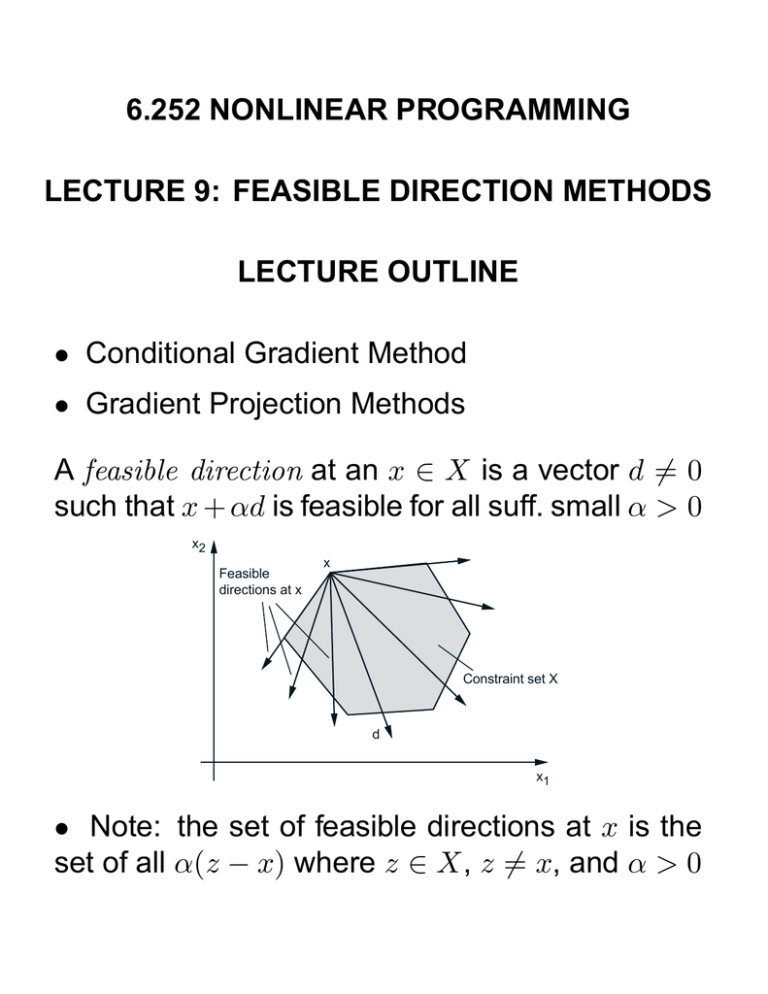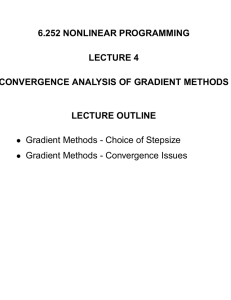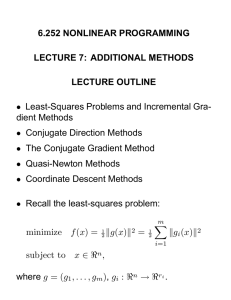Document 13501735
advertisement

6.252 NONLINEAR PROGRAMMING
LECTURE 9: FEASIBLE DIRECTION METHODS
LECTURE OUTLINE
• Conditional Gradient Method
• Gradient Projection Methods
A feasible direction at an x ∈ X is a vector d = 0
such that x + αd is feasible for all suff. small α > 0
x2
Feasible
directions at x
x
Constraint set X
d
x1
• Note: the set of feasible directions at x is the
set of all α(z − x) where z ∈ X, z = x, and α > 0
FEASIBLE DIRECTION METHODS
• A feasible direction method:
xk+1 = xk + αk dk ,
where dk : feasible descent direction [∇f (xk ) dk <
0], and αk > 0 and such that xk+1 ∈ X.
• Alternative definition:
xk+1 = xk + αk (xk − xk ),
where αk ∈ (0, 1] and if xk is nonstationary,
xk ∈ X,
∇f (xk ) (xk − xk ) < 0.
• Stepsize rules: Limited minimization, Constant
αk = 1, Armijo: αk = β mk s, where mk is the first
nonnegative m for which
f (xk )−f
xk +β m (xk −xk )
≥ −σβ m ∇f (xk ) (xk −xk )
CONVERGENCE ANALYSIS
• Similar to the one for (unconstrained) gradient
methods.
• The direction sequence {dk } is gradient related
to {xk } if the following property can be shown:
For any subsequence {xk }k∈K that converges to
a nonstationary point, the corresponding subsequence {dk }k∈K is bounded and satisfies
lim sup ∇f (xk ) dk < 0.
k→∞, k∈K
Proposition (Stationarity of Limit Points)
Let {xk } be a sequence generated by the feasible
direction method xk+1 = xk + αk dk . Assume that:
− {dk } is gradient related
− αk is chosen by the limited minimization rule
or the Armijo rule.
Then every limit point of {xk } is a stationary point.
• Proof: Nearly identical to the unconstrained
case.
CONDITIONAL GRADIENT METHOD
• xk+1 = xk + αk (xk − xk ), where
xk = arg min ∇f (xk ) (x − xk ).
x∈X
• Assume that X is compact, so xk is guaranteed
to exist by Weierstrass.
∇f(x)
Constraint set X
x
Illustration of the direction
of the conditional gradient
method.
_
x
Surfaces of
equal cost
Constraint set X
x0
x1
x2
_
x1
x*
Surfaces of
equal cost
_
x0
Operation of the method.
Slow (sublinear) convergence.
CONVERGENCE OF CONDITIONAL GRADIENT
• Show that the direction sequence of the conditional gradient method is gradient related, so the
generic convergence result applies.
• Suppose that {xk }k∈K converges to a nonstationary point x̃. We must prove that
k
k
x −x k∈K
: bounded,
lim sup ∇f (xk ) (xk −xk ) < 0.
k→∞, k∈K
• 1st relation: Holds because xk ∈ X, xk ∈ X,
and X is assumed compact.
• 2nd relation: Note that by definition of xk ,
∇f (xk ) (xk − xk ) ≤ ∇f (xk ) (x− xk ),
∀x ∈ X
Taking limit as k → ∞, k ∈ K, and min of the RHS
over x ∈ X, and using the nonstationarity of x̃,
lim sup ∇f (xk ) (xk −xk ) ≤ min ∇f (˜
x) (x−˜
x) < 0,
k→∞, k∈K
x∈X
thereby proving the 2nd relation.
GRADIENT PROJECTION METHODS
• Gradient projection methods determine the feasible direction by using a quadratic cost subproblem. Simplest variant:
xk+1 = xk + αk (xk − xk )
+
k
k
k
x = x − s ∇f (x )
k
where, [·]+ denotes projection on the set X, αk ∈
(0, 1] is a stepsize, and sk is a positive scalar.
xk+1 = xk - sk ∇f(xk )
Constraint set X
xk+2 - sk+2∇f(xk+2)
xk+1
xk
xk+3k+2
x
xk+1 - sk+1∇f(xk+1)
Gradient projection iterations for the case
αk ≡ 1,
xk+1 ≡ xk
If αk < 1, xk+1 is in the
line segment connecting xk
and xk .
• Stepsize rules for αk (assuming sk ≡ s): Limited
minimization, Armijo along the feasible direction,
constant stepsize. Also, Armijo along the projection arc (αk ≡ 1, sk : variable).
CONVERGENCE
• If αk is chosen by the limited minimization rule
or by the Armijo rule along the feasible direction,
every limit point of {xk } is stationary.
• Proof: Show that the direction sequence {xk −
xk } is gradient related. Assume{xk }k∈K converges
to a nonstationary x̃. Must prove
k
k
x −x k∈K
: bounded,
lim sup ∇f (xk ) (xk −xk ) < 0.
k→∞, k∈K
1st relation holds because x − xk k∈K converges to [x̃−s∇f (x̃)]+ −x̃
. By optimality condi
k k
k
tion for projections, x −s∇f (x )−x (x−xk ) ≤
0 for all x ∈ X. Applying this relation with x = xk ,
and taking limit,
+ 2
1
k k
k
lim sup ∇f (x ) (x −x ) ≤ − x̃− x̃−s∇f (x̃) < 0
k→∞, k∈K
k
s
• Similar conclusion for constant stepsize αk = 1,
sk = s (under a Lipschitz condition on ∇f ).
• Similar conclusion for Armijo rule along the projection arc.
CONVERGENCE RATE – VARIANTS
• Assume f (x) = 12 x Qx − b x, with Q > 0, and
a constant stepsize (ak ≡ 1, sk ≡ s). Using the
nonexpansiveness of projection
k+1
k
+ ∗
+ ∗
k
∗
x
− x = x − s∇f (x )
− x − s∇f (x ) k
∗
k
∗
≤ x − s∇f (x ) − x − s∇f (x ) k
∗
= (I − sQ)(x − x )
k
∗
≤ max |1 − sm|, |1 − sM | x − x where m, M : min and max eigenvalues of Q.
• Scaled version: xk+1 = xk +αk (xk −xk ), where
xk = arg min
x∈X
1
∇f (xk ) (x − xk ) + k (x − xk ) H k (x − xk )
2s
and H k > 0. Since the minimum value above is
negative when xk is nonstationary, ∇f (xk ) (xk −
xk ) < 0. Newton’s method for H k = ∇2 f (xk ).
• Variants: Projecting on an expanded constraint
set, projecting on a restricted constraint set, combinations with unconstrained methods, etc.
,







